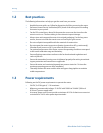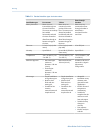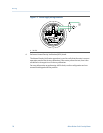
1.4 Other installation considerations
A variety of external factors exist that affect the ability of the meter to operate
successfully. To ensure that your system works correctly, consider the effects of these
factors when designing your installation.
1.4.1 Calibration boundaries
Important
Micro Motion calibrates all meters at the factory according to the sensor calibration range selected at
point of purchase. The factory calibration process takes into account the potential boundary effect of
the planned installation. At point of installation, confirm that the meter calibration range and
boundary matches the planned installation to ensure optimum performance of the meter. If the
meter calibration does not match the planned installation, measurement error may occur and you
will need to perform an onsite calibration.
The boundary effect of an installation refers to the sensitive, or effective, region of the
meter sensing device being interrupted by the boundary of the pipe walls. This effect can
vary based on the type of installation or the size of the pipeline diameter. Considering this
effect when calibrating the meter is important because the direct insertion meter can only
measure the properties of the fluid that are within the region that the meter is sensitive.
The vibration of the fork meter tines creates an effective measurement region that is
shaped as an ovoid centered on the tips of the tines. The long axis of the ovoid is aligned
with the direction that the tines are vibrating. The meter sensor is insensitive to any fluid
properties outside of this region, and progressively more sensitive to the fluid properties
the closer the fluid is to the meter tines (see Figure 1-3).
Planning
4 Micro Motion Fork Viscosity Meter


















